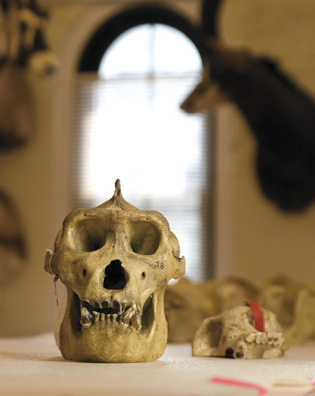 loading
loading
featuresThe missionary and the gorillaA nineteenth-century tale of disease, perseverance, scientific infighting, and a landmark of natural history. Guggenheim Fellow Richard Conniff ’73 is at work on a book about the discovery of species.  Mark OstowThe two gorilla skulls that Thomas S. Savage, Class of 1825, ’33MD, brought from Africa to the United states are stored today at Harvard's Museum of Comparative Zoology. Here, the male skull is in the foreground; one half of the female skull (which has been bisected, front to back), with a red label attached, lies to the right. View full imageOn July 16, 1847, a missionary newly arrived in New York City from West Africa packed a collection of bones in a box and shipped them off to a colleague in Massachusetts. In a letter, Thomas S. Savage ’25, ’33MD, admitted to being "quite unwell," probably meaning "utterly wretched." He had already endured tropical diseases in Liberia off and on for more than a decade, and he'd seen his first two wives languish and die there, probably of malaria. He wasn't the sort to complain lightly. In any case, his weakened state was evident. He had at first misplaced the list of contents for the box. And despite his original plan "to describe the bones of the animal myself," he had to ask his colleague to handle that chore. Describing the creature's habits "will be about all that I shall be able to do." A few weeks later, as he recuperated at his family home in Middletown, Connecticut, he wrote again: "Will you inform me whether you received the two canine teeth of the best male cranium? I remember that one came out, but cannot tell whether I replaced it. I have not seen it since I sent the bones." What he sent was sensational enough. In mid-August at the Boston Society of Natural History, Savage and his coauthor, Harvard anatomist Jeffries Wyman, together presented one of the most startling and important discoveries in the science of life on Earth, a disturbingly humanoid creature that would soon enter popular lore and also play a key part in the coming debate over Darwinian evolution. They called their new species "gorilla." A casual reader browsing through the biological literature today could easily get the impression that the gorilla was introduced to Westerners by Richard Owen, the ambitious British paleontologist best known for coining the name "dinosaur" and for disputing Darwin. Credit also sometimes goes to the American explorer Paul du Chaillu, who in the 1850s became the first Westerner to give the outside world an eyewitness account of gorillas in the wild. One BBC website even seems to credit the discovery to an otherwise unknown British sea captain named George Wagstaff, who acquired several gorilla skulls while trading in 1847 on the coast of Gabon, at the same time as Savage: "Before these items were collected, gorillas were thought mythical. . . . Captain Wagstaff died soon after arriving in Bristol and the full story of these first skulls went with him to the grave." In fact, the scientific discovery of the gorilla was entirely a collaboration between Savage and Wyman, one from Yale, the other from Harvard, both trained as physicians, both from old and somewhat starchy New England stock. At a time when many scientists competed fiercely to discover new species, even stealing credit from one another, the two American naturalists were meticulously fair and almost comically modest. Thus when Wyman, the professional anatomist, entered the new species into the annals of science, he sidestepped scientific immortality and named Savage as the describer: Troglodytes gorilla, Savage. Savage responded in turn with courtly dismay: "I . . . very much regret that you have done it; for it cannot be an honest act on my part to desire to appropriate to myself that to which I have no claim. I look upon you as the describer." For their gentlemanly behavior, history has largely forgotten them. Savage was the key to the discovery, in the right place and with the right background to recognize from a single skull the existence of the largest primate on Earth, a creature Richard Owen would later describe as "the most portentous & diabolical caricature of humanity that an atrabilious poet ever conceived or a naturalist ever realized." Except for vague rumors, this behemoth had somehow escaped the attention of Europeans traveling the coast of West Africa for the previous 400 years.
|
|